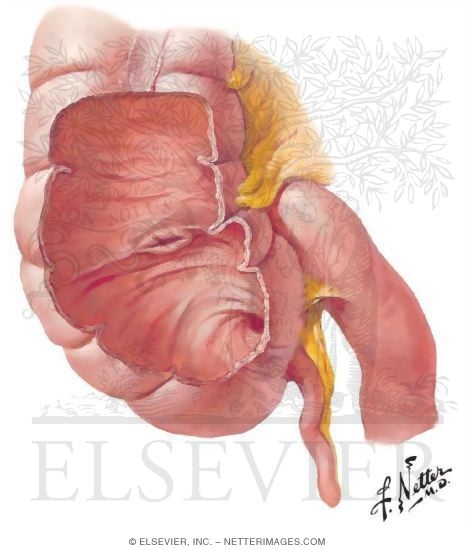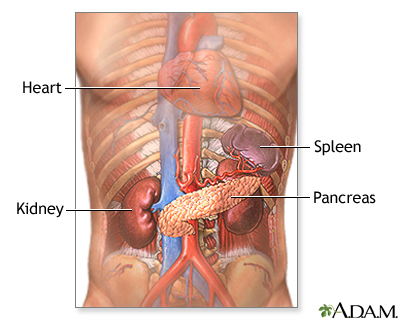The GI System
The group of organs that break down food and absorb the nutrients used by the body for fuel. The organs in the digestive system, in the order in which food travels through them, are: Mouth
Esophagus
Stomach
Small Intestine
Large Intestine
Rectum
Anus
Mouth
Esophagus
Stomach
Small Intestine
Large Intestine
Rectum
Anus
Parts of food which cannot be broken down, digested, or absorbed are excreted as bowel movements.

The gastro-intestinal system is essentially a long tube running right through the body, with specialised sections that are capable of digesting material put in at the top end and extracting any useful components from it, then expelling the waste products at the bottom end. The whole system is under hormonal control, with the presence of food in the mouth triggering off a cascade of hormonal actions; when there is food in the stomach, different hormones activate acid secretion, increased gut motility, enzyme release etc. etc.
Nutrients from the GI tract are not processed on-site; they are taken to the liver to be broken down further, stored, or distributed
oesophagus.
Once food has been chewed and mixed with saliva in the mouth, it is swallowed and passes down the oesophagus. The oesophagus has a stratified squamous epithelial lining (SE) which protects the oesophagus from trauma; the submucosa (SM) secretes mucus from mucous glands (MG) which aid the passage of food down the oesophagus. The lumen of the oesophagus is surrounded by layers of muscle (M)- voluntary in the top third, progressing to involuntary in the bottom third-
and food is propelled into the stomach by waves of peristalisis.

The
stomach is a 'j'-shaped organ, with two openings- the oesophageal and the duodenal- and four regions- the cardia, fundus, body and pylorus. Each region performs different functions; the fundus collects digestive gases, the body secretes pepsinogen and hydrochloric acid, and the pylorus is responsible for mucus, gastrin and pepsinogen secretion.
The stomach has five major
functions;
Temporary food storage
Control the rate at which food enters the duodenum
Acid secretion and antibacterial action
Fluidisation of stomach contents
Preliminary digestion with pepsin, lipases etc
The Stomach - Histology
Key:
G- mucosa containing glandular tissue; different areas of the stomach contain different types of cells which secrete compounds to aid digestion. The main types involved are:
parietal cells which secrete hydrochloric acid
chief cells which secrete pepsin
enteroendocrine cells which secrete regulatory hormones.
MM- muscularis mucosae
SM- submucosa
The stomach contains three layers of involuntary smooth muscle which aid digestion by physically breaking up the food particles;
OM- inner oblique muscle
CM- circular muscle
LM- outer longditudional muscle
The Small Intestine (1)
The small intestine is the site where most of the chemical and mechanical digestion is carried out, and where virtually all of the absorption of useful materials is carried out. The whole of the small intestine is lined with an absorptive mucosal type, with certain modifications for each section. The intestine also has a smooth muscle wall with two layers of muscle; rhythmical contractions force products of digestion through the intestine (peristalisis). There are three main sections to the small intestine;
The duodenum forms a 'C' shape around the head of the pancreas. Its main function is to neutralise the acidic gastric contents (called 'chyme') and to initiate further digestion; Brunner's glands in the submucosa secrete an alkaline mucus which neutralises the chyme and protects the surface of the duodenum.
The jejunum
The ileum. The jejunum and the ileum are the greatly coiled parts of the small intestine, and together are about 4-6 metres long; the junction between the two sections is not well-defined. The mucosa of these sections is highly folded (the folds are called plicae), increasing the surface area available for absorption dramatically.

The pancreas consists mainly of exocrine glands that secrete enzymes to aid in the digestion of food in the small intestine. the main enzymes produced are lipases, peptidases and amylases for fats, proteins and carbohydrates respectively. These are released into the duodenum via the duodenal ampulla, the same place that bile from the liver drains into.
Pancreatic exocrine secretion is hormonally regulated, and the same hormone that encourages secretion (cholesystokinin) also encourages discharge of the gall bladder's store of bile. As bile is essentially an emulsifying agent, it makes fats water soluble and gives the pancreatic enzymes lots of surface area to work on.
structurally, the pancreas has four sections; head, neck, body and tail; the tail stretches back to just in front of the spleen

The Large Intestine
By the time digestive products reach the large intestine, almost all of the nutritionally useful products have been removed. The large intestine removes water from the remainder, passing semi-solid faeces into the rectum to be expelled from the body through the anus. The mucosa (M) is arranged into tightly-packed straight tubular glands (G) which consist of cells specialised for water absorption and mucus-secreting goblet cells to aid the passage of faeces. The large intestine also contains areas of lymphoid tissue (L); these can be found in the ileum too (called Peyer's patches), and they provide local immunological protection of potential weak-spots in the body's defences. As the gut is teeming with bacteria, reinforcement of the standard surface defences seems only sensible...
role of liver
